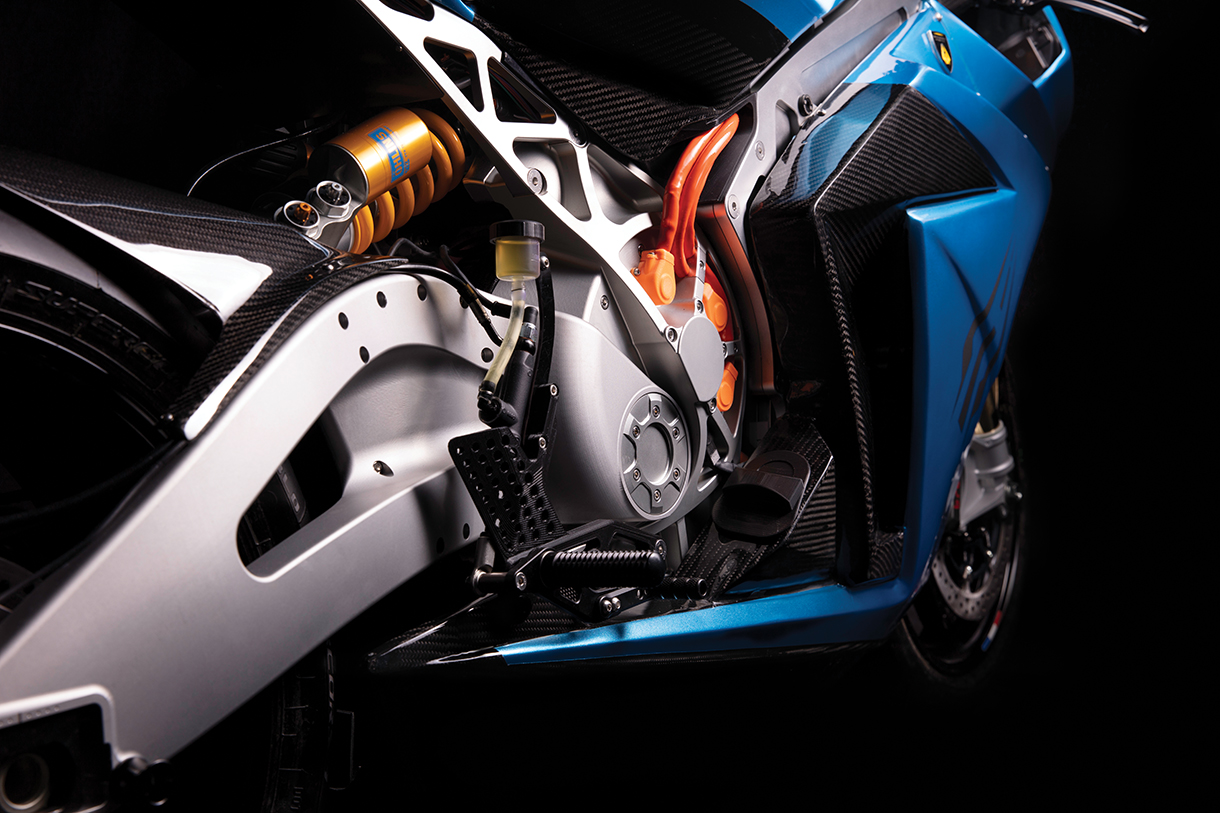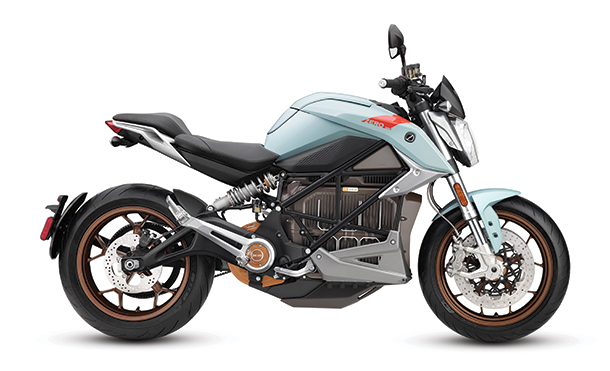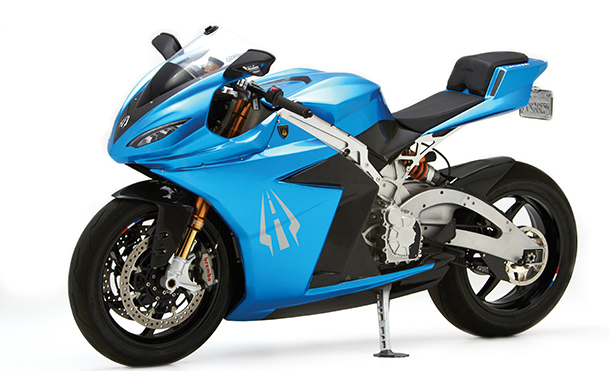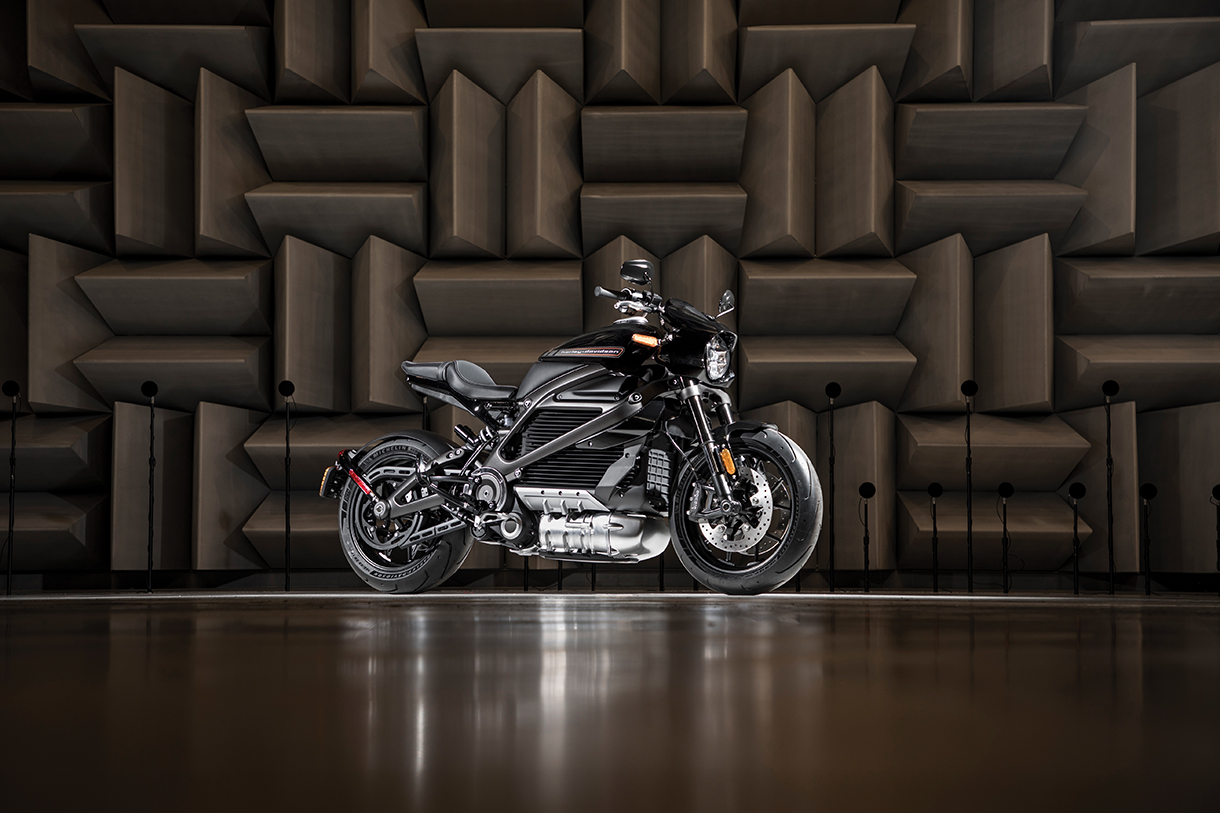
Charge of the E-Brigade
Electric motorcycles may be quieter than their gas-powered counterparts, but don’t underestimate their thrills.

Zero SR/F
Zero’s StReet/Fighter sets a new bar for mid-level e-bikes in terms of performance. As with other e-motorcycles, Zero’s goal is to provide a bike that’s not just electric but also electrifying when ridden. So, the SR/F looks, feels, and rides like, well, a motorcycle. With naked-bike styling, the trellis frame encases an exposed battery and motor, with beefy tires front and rear to complete the picture. A relatively low 31-inch seat height lets most riders put their feet flat; the tapered bars allow for a slightly forward-leaning stance on the move.
Inside, the SR/F has a compact ZF75-10 motor, putting out 110 hp at 4,500 rpm, but the real reason for this bike is the 146.5 ft lbs of torque at 1,200 rpm. What makes this bike fun to ride is that seamless power delivery from the first moment, without gears and clutches, that you get from an electric motor. You’re always in the right gear, all the time. Top speed is limited to 124 mph and, adding to the fun, the four driving modes, Street, Sport, Eco, and Rain (plus 10 more custom modes), make the SR/F extremely controllable. Each mode changes torque delivery and regeneration settings. Bosch’s MSC System provides straight line and cornering ABS, along with traction and drag control: 4-pot J. Juan 320 mm brakes up front, and 240 mm in the rear, provide stopping power. Showa front forks and rear piston are adjustable for preload, compression, and rebound damping. At 485 pounds, the bike requires some additional input from the pegs and bars to get over, but the adjustable suspension and Pirelli Diablo Rosso III tires work their magic to get the bike handling like a café racer. The standard SR/F has a combined range of 123 miles, plus the Power Tank boosts the range up to 200 miles, but you lose the “fuel tank” storage compartment. With the rapid charge system, a full charge takes 1.8 hours. $19,495; zeromotorcycles.com

Lightning LS-218
If it’s real speed you need, hop on a Lightning LS-218—and hold on. The name says it all: The LS-218 boasts a top speed of 218 mph, making it the fastest production electric motorcycle. It’s also the fastest production motorcycle, period. The LS-218’s IPM liquid-cooled 180 kW motor puts out 241 hp, and a whopping 220 ft lbs of torque, all of which is available from takeoff. So, yes, twist that throttle, but grab on tight because this is a race bike designed for the track, with low clip-on bars and a hard seat. It’ll do 0 to 60 mph in under 2 seconds and 0 to 100 in 5 seconds. Top speed is nominally 184 mph, but with the optional rear sprocket and aero fairing, the LS-218 will live up to its name, hitting 218 mph. If you dare. The bike is so fast, it comes with its own racing data acquisition software pre-programmed. Don’t expect much from the dash, however, unless you’re actually on the track: most of the metrics deal with racing, with the exception of the tach and battery indicators. Speaking of batteries, the stock range is 100 miles, but with the optional 20 kW battery pack, that goes up to 160–180 miles.
At 495 pounds, Lightning is no lightweight, but the handling is top-notch. In fact, this bike won the 2013 Pikes Peak race by 20 seconds over the next finisher. Massive 320 mm Brembo disc brakes, with forged 4-piston calipers, slow things down quickly; programmable regenerative braking also helps, and has the added bonus of putting some charge in the proverbial tank (sorry, battery). Available Ohlins FRGT front forks, fully adjustable for preload, compression, and rebound, keep the LS-218 stable, along with an Ohlins TTX36 shock in the rear (also fully adjustable for preload), high and low speed compression and rebound, and ride height. It’s not just the bike that’s fast: with a DC fast charger, you can be back on the road with a full charge in as little as 30 minutes. $38,885; lightningmotorcycle.com

Harley-Davidson LiveWire
Is it a surprise that the king of twin-engine cruisers has jumped into the electric bike circuit? Not really. In a search for new riders, Harley-Davidson unleashed its LiveWire model with a design that both shows its wild side and pays homage to the brand’s classic look. Although the price point is high, the LiveWire clarifies Harley’s intention of showcasing its e-bike capabilities to create a platform for future models. The open styling shows off the finned battery case, bolted to the frame as a stressed member, with the motor, tucked underneath, looking like it was stolen from a jet. While not generating the traditional Harley lumpy growl, the LiveWire does give up a pleasant whirring noise reminiscent of a Star Wars Speeder. It also has a haptic pulse, like a heartbeat, to remind the rider it’s on. That permanent magnet DC motor, the Harley-Davidson Revelation, generates 105 hp and 86 ft lbs of torque. The torque engages instantly, rocketing the LiveWire from 0 to 60 in under 3 seconds.
In another unexpected move, Harley went outside to source parts (the list includes a set of Brembo brakes and an adjustable Showa front and rear suspension), but included its proprietary Reflex Defensive Rider system with lean-sensitive ABS, traction control, drag-torque slip control, and rear-wheel lift control. Given the bike’s 549-pound weight, the ABS comes in handy at turns under hard front and rear braking. Tucking the Level 1 Charger under the seat is a nice touch, and in under one hour you can do a quick DC recharge at any participating Harley-Davidson dealer or public charging station. Use the touch screen LCD dash to select one of four drive modes (Sport, Road, Range, or Rain), or set up to three customized modes. The regenerative braking system adjusts to increase its range. Connect to the internet for remotely monitoring battery charge status, tamper alerts, and vehicle location.
In terms of handling, the LiveWire has a more aggressive forward position than expected from Harley, with wider bars that create a more relaxed reach with better leverage for upper-body inputs. Reasonably wide tires, and a surprisingly firm ride, provide excellent grip and stability. Another welcome surprise: The handling characteristics tend toward those of sport bikes, not cruisers. With a lean angle of 45 degrees, don’t hesitate to go hard into some back roads. The low engine and low center of gravity help. Just don’t go too far into the country; the range is 95 miles combined. Harley claims 146 miles in city driving, but as with all e-bikes, be cautious. $29,995; harley-davidson.com




